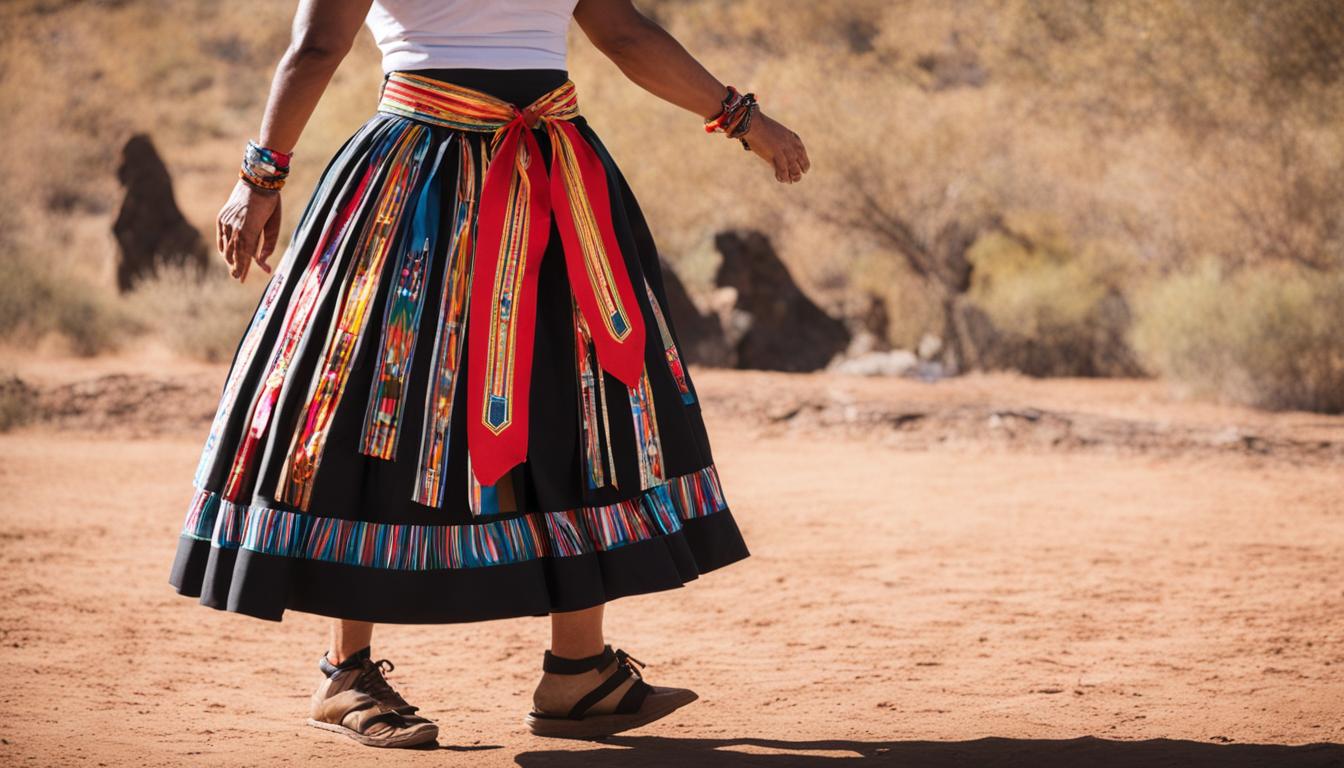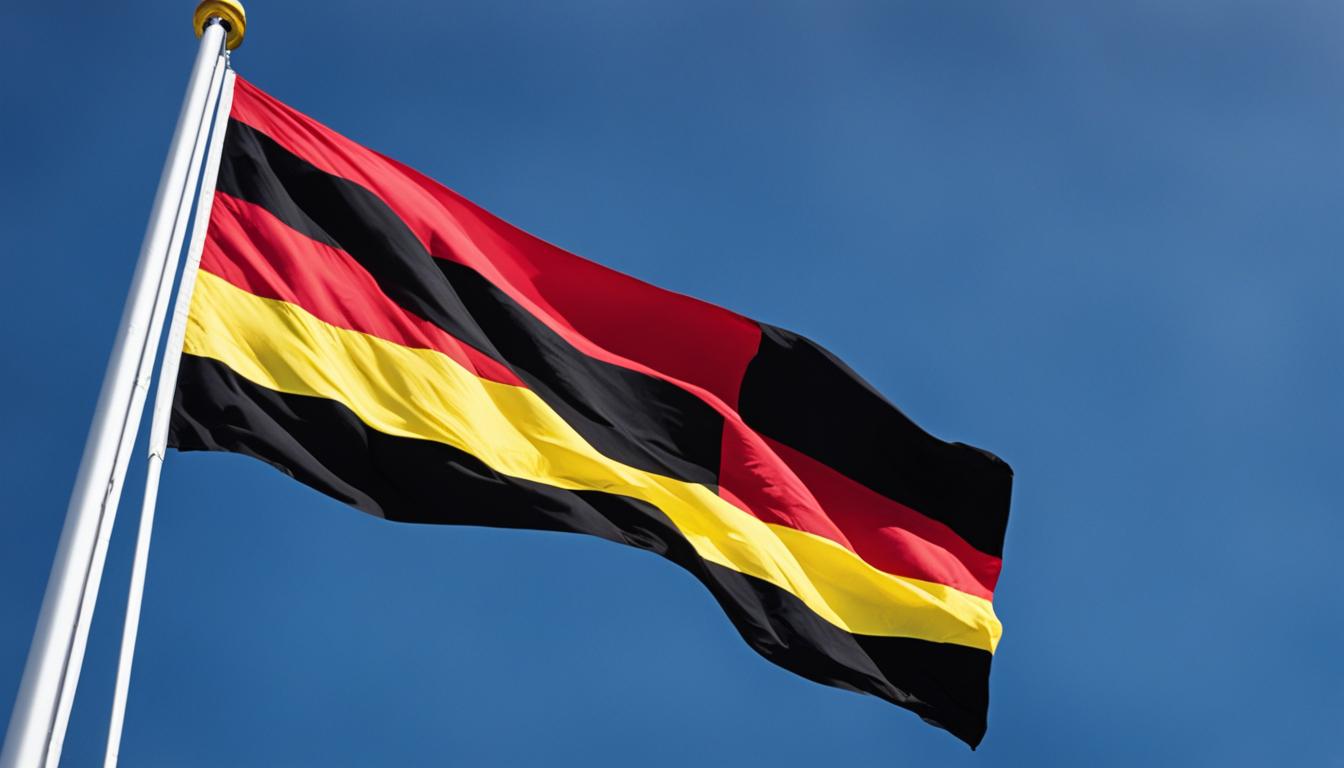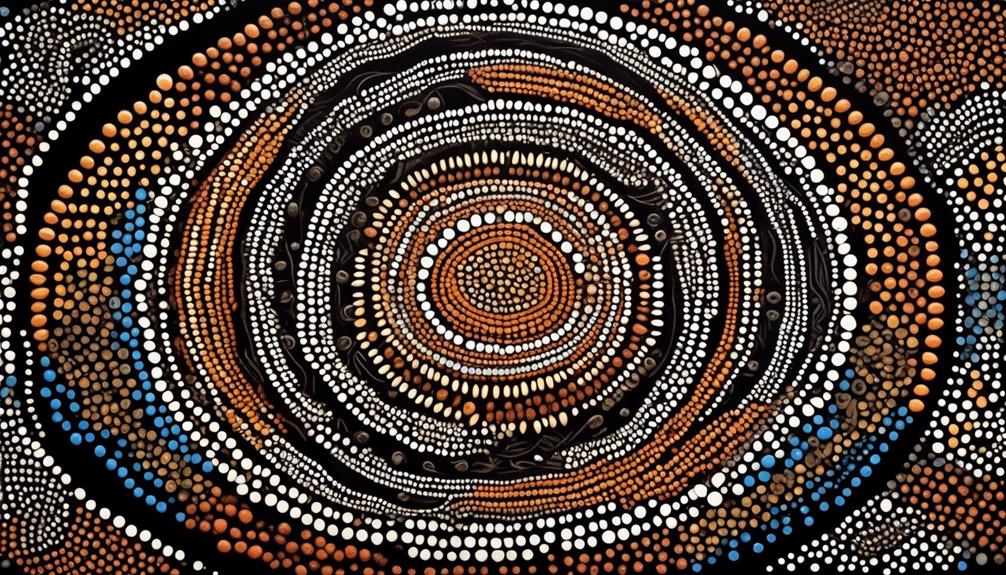Indigenous totems hold great significance in Aboriginal cultures, representing a strong spiritual connection to ancestors, the earth, and the natural world. While the meaning and symbolism of these totems may vary depending on the location and Clan, they consistently foster a profound spiritual connection among people, providing a sense of identity and belonging to the community.
Key Takeaways:
- Aboriginal totems connect individuals to their Clan, traditional land, and the Dreaming.
- Totems are natural objects, plants, or animals inherited as spiritual emblems.
- They define roles, responsibilities, and relationships within the community.
- Personal totems are individually assigned during Coming of Age Ceremonies.
- Totems foster a deep understanding and respect for nature and cultural heritage.
The Indigenous Perspective on Totems
The First Australians have a deep connection with country, its animals, plants, and places. They believe that the spirits of their Dreamtime ancestors dwell in sacred sites, and these ancestral spirits can also be recognized in the behavior of native animals. Totems have complex layers deeply embedded in Indigenous culture. They can be natural objects, plants, or animals inherited as spiritual emblems, defining roles, responsibilities, and relationships within the community. Totems are seen as heroes and spiritual guides.
Indigenous cultures celebrate the rich symbolism and spiritual significance of totems. Totems bridge the gap between the physical and spiritual realms, embodying the interconnectedness of all living beings and the natural world. With totems as their guides, Indigenous communities have a profound understanding of their connection to the land and their ancestral lineage.
- Totems represent a spiritual connection to ancestors, embodying their wisdom and guidance.
- They symbolize the unique relationship between Indigenous peoples and the natural world.
- Totems serve as reminders of the responsibilities and roles individuals have within their communities.
Through their ancestral connection, Indigenous peoples gain a deeper understanding of the world around them. Totems provide a sense of belonging, identity, and cultural heritage. They foster a profound respect for nature and the preservation of traditional knowledge and practices.
| Totems in Indigenous Perspective | Key Characteristics |
|---|---|
| Heroes and Spiritual Guides | Totems are revered as heroes and spiritual guides, offering wisdom, protection, and guidance in life. |
| Symbolism and Significance | Totems hold deep symbolic meaning, reflecting the spiritual connection to ancestors, land, and the natural world. |
| Roles and Responsibilities | Totems define roles, responsibilities, and relationships within the community, shaping social structures. |
| Bridging the Physical and Spiritual Realms | Totems serve as a bridge between the physical and spiritual realms, embodying the interconnectedness of all living beings. |
The Indigenous perspective on totems highlights the profound spiritual and cultural significance they hold. These spiritual emblems not only connect Indigenous peoples to their ancestral past but also guide them in their present and future, fostering a deep sense of belonging, respect, and harmony with the land and its rich heritage.
Aboriginal Totems and Ancestral Connections
Aboriginal totems hold a profound connection to ancestral heritage and the land. According to the beliefs of the first Australians, the spirits of their Dreamtime ancestors continue to inhabit sacred places on the land. These ancestral spirits can be encountered in ancient trees, rock formations, or recognized through the behavior of native animals. Through the complex symbolism of totems, individuals forge relationships with one another and with creation, establishing a deep connection to the land and the spirits of those who came before.
The significance of totems lies in their ability to bridge the gap between the past and the present, acting as a tangible representation of ancestral wisdom and spirituality. Aboriginal communities perceive totems as spiritual guides, embodying the essence of their ancestors and their profound understanding of the land and its inhabitants.
“Totems are not simply objects or animals; they are the embodiment of our ancestors, guiding us in our journey through life and preserving our cultural heritage.”
These ancestral connections are reflected in the intricate relationships Aboriginal peoples have with their totems. Totems aid in defining roles, responsibilities, and kinship ties within the community, reinforcing the interconnectedness between humans, wildlife, and the land itself. By recognizing and honoring their ancestral lineage through totems, individuals establish a profound sense of identity and belonging, fostering a culture of respect and stewardship for both the natural and spiritual realms.
Iconic Examples of Aboriginal Totems
| Totem | Significance |
|---|---|
| The Kangaroo | |
| The Emu | |
| The Barramundi |
These totems, among others, represent the unique bond between Aboriginal peoples and their traditional lands. They serve as spiritual conduits, embodying the wisdom, guidance, and connection to country that has been passed down through generations.
Through their deep ancestral connections, Aboriginal totems continue to play a vital role in shaping the cultural identity, social structure, and environmental stewardship of Indigenous communities across Australia.
Spiritual Significance of Aboriginal Totems
Aboriginal totems hold deep spiritual significance within Indigenous cultures, serving as a powerful connection between individuals and the spiritual world. They are believed to link us directly with the ancestors of the Dreamtime, providing guidance, wisdom, and a sense of belonging to something greater than ourselves. Totems are seen as spiritual guides, leading us on our journey through life and symbolizing the ancestral wisdom passed down through generations.
Through our totems, we forge a sacred bond with creation and gain a deeper understanding of our place in the world. They serve as tangible representations of our ancestral heritage, carrying forward the knowledge, traditions, and cultural practices of our ancestors. By honoring and respecting our totems, we honor the spirits of those who came before us and the wisdom they imparted.
“Our totems are not just symbols or emblems; they are a living connection to our past, present, and future. They are our teachers and guides, reminding us of our responsibilities to our community, the land, and all living beings.”
In Indigenous belief systems, totems are revered as sacred beings with their own spirits. They communicate with us through words, dance, and ceremony, providing guidance, protection, and inspiration. The spiritual significance of Aboriginal totems extends beyond individual experiences to encompass the interconnectedness of all living beings. They remind us of our place in the Sacred Web of Life and nurture a deep respect for the spirits that dwell within animals, plants, and the natural environment.
By embracing our totems and their spiritual significance, we gain a profound understanding of our roots, culture, and connection to country. We recognize that we are not separate from nature, but an integral part of it, with a shared responsibility to care for and protect the land and its inhabitants.
| Key Points: | Benefits: |
|---|---|
| We forge a spiritual connection through totems | Deepens our understanding of our place in the world |
| Totems serve as spiritual guides and symbols of ancestral wisdom | Leads us on our life journey and imparts valuable knowledge |
| Totems honor our ancestral heritage | Preserves the traditions and cultural practices of our ancestors |
| Totems are revered as sacred beings with their own spirits | Provides guidance, protection, and inspiration |
| Totems foster a deep respect for nature and the interconnectedness of all living beings | Helps us recognize our shared responsibility to care for and protect the land and its inhabitants |
Cultural Significance of Aboriginal Totems
Aboriginal totems hold immense cultural significance in Indigenous communities across Australia. They serve as symbols of identity, representing one’s Clan, Nation, and family group. Totems are more than just symbols; they define roles, responsibilities, and relationships within the community.
These spiritual emblems are deeply embedded in cultural practices, ceremonies, and sacred rituals, playing a vital role in connecting individuals to their ancestral heritage. Aboriginal people view totems as an essential link between humans, wildlife, and the land.
“Our totems are like a roadmap that guides us through the intricate web of our cultural heritage. They remind us of our place in the world and our responsibility to the natural environment.”
Totems foster a deep understanding and respect for the natural environment, emphasizing the importance of its preservation. They encourage individuals to care for and protect wildlife and their habitats, ensuring the sustainability of cultural heritage.
Through totemism, Aboriginal communities maintain a harmonious relationship with the land, reinforcing their cultural identity and promoting a sense of unity and belonging.
The Role of Totems in Aboriginal Cultural Practices
The cultural importance of Aboriginal totems extends beyond symbolism. They guide individuals in their interactions with the land and other community members, fostering harmony, respect, and the preservation of cultural traditions.
Traditionally, totems are intricately tied to social structures, kinship systems, and ceremonial practices. They dictate specific roles, responsibilities, and even decision-making processes within the community.
For example, certain totems may be associated with particular foods, rituals, or tasks, highlighting the interconnectedness of people, wildlife, and the land in Aboriginal culture.
Totems enable individuals to navigate their social environment, ensuring cohesion, cooperation, and intergenerational knowledge transfer.
Cultural Significance of Aboriginal Totems
| Totem Significance | Examples |
|---|---|
| Symbol of Identity | Kangaroo, Emu, Snake |
| Guide to Relationships | Brother-Sister, Mother-Father |
| Responsibilities and Roles | Protector, Storyteller, Healer |
| Cultural Practices and Ceremonies | Dreaming Stories, Dance, Song |
| Connection to Land and Heritage | Mountains, Rivers, Sacred Sites |
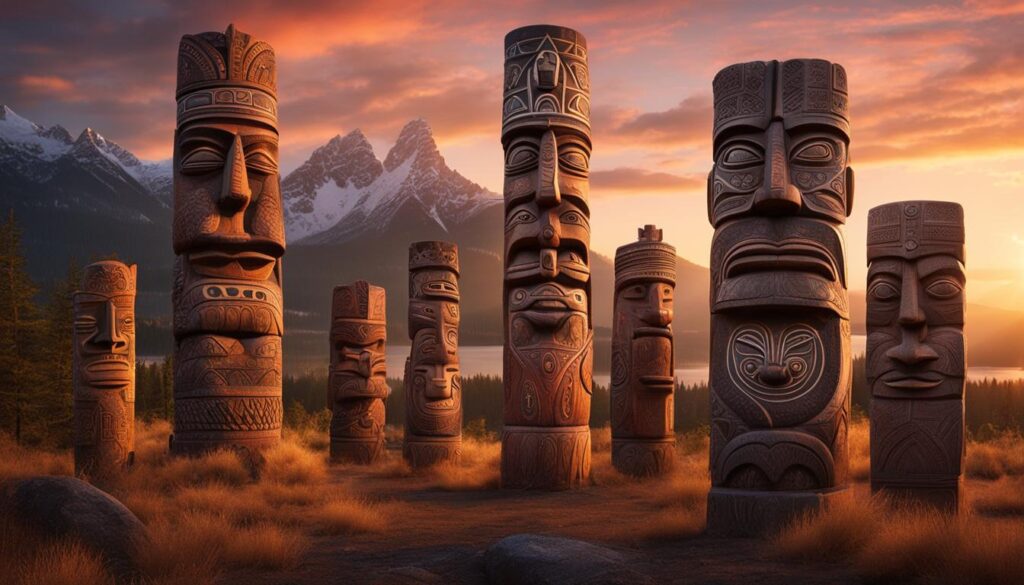
The cultural significance of Aboriginal totems continues to shape the unique identity and heritage of Indigenous communities. It fosters a deep understanding and respect for the natural environment, reinforcing the bond between humans, wildlife, and the land.
Traditional Role of Aboriginal Totems
In traditional Aboriginal culture, totems play a crucial role in defining social structures and responsibilities. They are not just symbols or decorations; instead, they hold deep meaning and significance in the lives of Indigenous peoples. Totems are regarded as spiritual guides, representing a person’s connection to their ancestors, land, and the natural world.
Aboriginal people believe that totems are passed down through generations, preserving the wisdom and knowledge of their ancestral lineage. Each individual is assigned a specific totem, which provides a sense of belonging and identity. This personal totem guides their interactions with the community and the environment, promoting harmony, respect, and the preservation of cultural traditions.
H3: Connection to Ancestry and Land
The traditional role of aboriginal totems extends beyond personal identity. Totems also strengthen the bond between individuals and their ancestral land. They reflect the deep connection Aboriginal people have with the land, its animals, plants, and natural elements. By honoring and respecting their totems, Indigenous communities maintain a spiritual and cultural relationship with the land, honoring their ancestors and preserving their connection to country.
H3: Social Structures and Responsibilities
Totems also play a vital role in defining social structures and responsibilities within Aboriginal communities. They establish a person’s role, status, and relationships with others. This helps maintain a harmonious and balanced community, where everyone understands their place and responsibilities.
“Our totems guide us in maintaining a respectful and harmonious relationship with the land, animals, and other community members. They remind us of our duty to preserve our cultural heritage and protect the environment for future generations.”
H3: Promoting Cultural Traditions
Through their traditional role, aboriginal totems promote the preservation of cultural traditions. They guide individuals in practicing ceremonies, rituals, and customs that are integral to their cultural identity. Totems serve as a reminder of the importance of cultural heritage and the wisdom passed down from previous generations.
H3: Nurturing Respect for the Natural World
By embodying the spiritual essence of animals, plants, and natural elements, totems foster a deep respect for the natural world. Aboriginal people understand the interconnectedness and interdependence of all living beings. Totems encourage a harmonious relationship with nature, teaching individuals to be mindful of their impact and to protect the environment for future generations.
H3: Preserving Aboriginal Culture
Aboriginal totems are more than cultural artifacts – they are the lifeblood of Indigenous culture. They are a powerful symbol of identity, a reminder of ancestral wisdom, and a guide for living in harmony with the land and community. The traditional role of aboriginal totems ensures the preservation of Aboriginal culture, passing down knowledge, values, and practices to future generations.
| Role | Description |
|---|---|
| Social Structure | Defines social roles, responsibilities, and relationships within the community |
| Connection to Ancestry | Strengthens the bond between individuals and their ancestral lineage |
| Cultural Preservation | Preserves cultural traditions, ceremonies, rituals, and customs |
| Respect for the Natural World | Fosters a deep respect for the environment and promotes sustainable practices |
| Preservation of Aboriginal Culture | Ensures the transmission of knowledge, values, and practices to future generations |
Totems in Indigenous Belief Systems
Totems hold significant importance in Indigenous belief systems. They can be animals, plants, or natural objects that are deeply revered and considered sacred. Totems are believed to have their own spirits and can communicate with humans through words, dance, and ceremony. Indigenous cultures see themselves as equal participants in the Sacred Web of Life, valuing and respecting the spirits of all living beings. Totems are seen as spiritual guides that provide wisdom, protection, and guidance on one’s life journey.
Indigenous belief systems view totems as more than mere symbols; they are embodiments of spiritual energy and connection. The deep reverence for totems is rooted in the understanding that everything in nature is interconnected and that each living being has its own unique spirit and purpose. By engaging with their totems, Indigenous communities cultivate a profound sense of harmony, balance, and interconnectedness with the natural world.
Deep Spiritual Connection
The spiritual connection to totems is a core aspect of Indigenous belief systems. Indigenous peoples understand that totems are not mere representations but beings with their own consciousness. They believe that totems possess inherent wisdom and spiritual power, which they can share with individuals who seek their guidance.
Indigenous cultures traditionally engage with totems through various practices and rituals, including storytelling, song, dance, and artwork. These cultural expressions not only honor the spirits of the totems but also serve as ways to connect with their wisdom and teachings.
“Our totems are more than symbols; they are living beings with their own spirits. We communicate with them and learn from their wisdom and guidance.”
The Power of Totems
Totems play a multifaceted role in Indigenous belief systems. They provide wisdom, protection, and guidance throughout an individual’s life journey. Indigenous peoples believe that by aligning themselves with their totems, they can tap into the spiritual energy and power of these sacred beings.
Through their totems, Indigenous communities gain a deeper understanding of their place in the world and their responsibilities towards the land and all living beings. The relationship with totems fosters a sense of respect for the natural environment, promoting sustainable practices and the preservation of cultural traditions.
A Visual Representation
| Totem | Symbolism |
|---|---|
| Kangaroo | Strength, agility, and adaptability |
| Eagle | Wisdom, vision, and spiritual guidance |
| Snake | Healing, transformation, and renewal |
| Emu | Provider, nurturer, and perseverance |
Indigenous communities have a diverse range of totems, each with its own unique symbolism and spiritual significance. The table presents some common totems and their associated meanings, but it is important to note that totems can vary across different Indigenous cultures and regions.
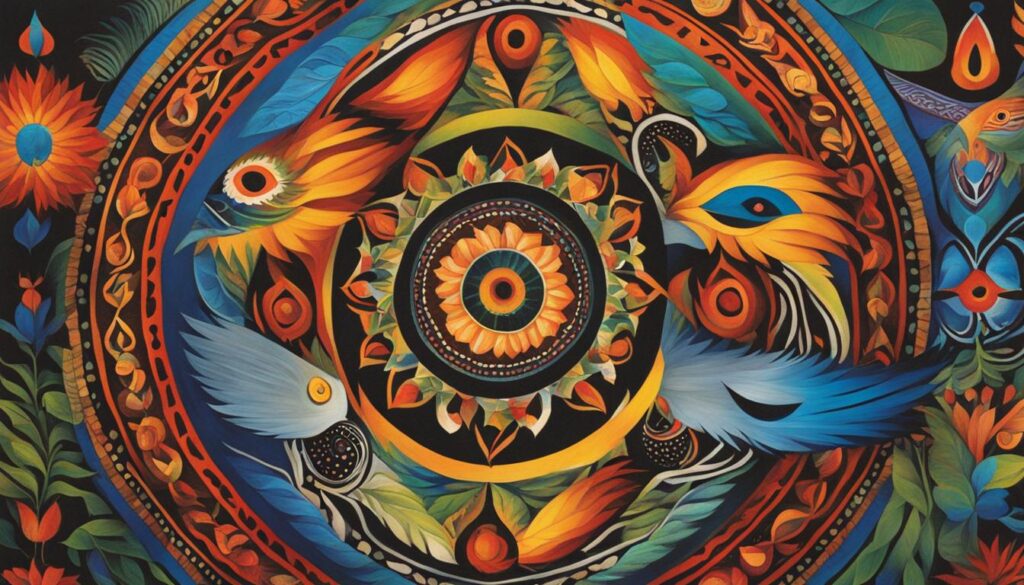
Totems and Ancestral Wisdom
In Aboriginal culture, totems hold a profound significance as carriers of ancestral wisdom. They serve as a strong connection between past generations and present-day individuals, fostering a deep understanding of knowledge, traditions, and spiritual guidance.
Through their totems, individuals not only cultivate a relationship with their immediate family and Clan but also tap into the collective wisdom of their entire Nation. This connection to ancestral wisdom nurtures a strong sense of identity and cultural heritage, shaping the way individuals navigate their lives and relationships.
“Our totems are like bridges that span across time, connecting us to our ancestors and their wisdom. They guide us, inspire us, and remind us of our roots.”
Understanding and honoring the wisdom embedded in totems is fundamental to Aboriginal culture. It emphasizes the importance of preserving tradition and passing on valuable knowledge to future generations.
Connecting with the Spirit of Ancestors
Each totem represents a spiritual link to the ancestors who first encountered and embraced the living world. These ancestral spirits reside in the totems, guiding and protecting individuals as they navigate their journey through life.
“Our totems carry the essence of our ancestors, reminding us of their resilience, wisdom, and connection to the land. They are an open channel through which their spirits communicate and guide us.”
By embracing their totems, individuals gain access to the rich wisdom and spiritual guidance that has been passed down through countless generations. This connection provides a sense of rootedness and purpose, strengthening their identity and cultural belonging.
The Power of Cultural Heritage
Aboriginal totems are not just emblematic of personal identity but also represent the collective heritage of entire Nations. They encapsulate the shared memories, traditions, and values that have shaped Aboriginal communities for thousands of years.
By cherishing and upholding the cultural significance of totems, Aboriginal communities preserve their identity, ensuring that future generations can benefit from the wisdom and teachings of their ancestors. This commitment to cultural heritage fosters a deep sense of pride, respect, and responsibility for the land and all living beings.
“Our totems are not just symbols, but living embodiments of our ancestral wisdom. They are threads that connect us to the past, weaving together the present and informing our future.”
Embracing the wisdom of totems enables Aboriginal communities to navigate the complexities of the modern world while honoring and preserving their unique cultural heritage.
| Ancestral Wisdom | Connection to Identity | Cultural Preservation |
|---|---|---|
| Guides individuals through life, sharing the wisdom of past generations | Strengthens individual and collective identity | Safeguards cultural heritage for future generations |
| Provides spiritual guidance and protection | Enhances a sense of belonging and cultural belonging | Preserves traditions, knowledge, and teachings |
| Connects individuals to their ancestors and shared ancestral wisdom | Nurtures respect for ancestral traditions and values | Transmits cultural wisdom to future generations |
Toteming and Connection to Land
Aboriginal totems hold great significance when it comes to the connection with the land. They represent the deep bond between Indigenous peoples and their ancestral territories. Totems go beyond being symbolic of just the animals and plants that inhabit the land; they also embody the spiritual essence and wisdom that emanate from it.
Through their totems, individuals maintain a profound spiritual and cultural relationship with the land. They honor their ancestors and preserve their spiritual and physical connection to country. Totems serve as a constant reminder of the interdependence between Indigenous peoples and the natural environment, fostering a deep respect for the land and its inhabitants.
“Our totems not only represent the animals and plants that are part of our traditional lands but also encapsulate our spiritual and cultural connection to country. They remind us of our responsibility to care for the land and ensure its preservation for future generations.”
This connection to the land through totems is deeply ingrained in Aboriginal culture. It is a fundamental aspect of Indigenous identity and plays a crucial role in shaping the values, traditions, and practices of Aboriginal communities. The significance of aboriginal totems extends beyond their symbolic nature; they embody the deep-rooted connection Aboriginal peoples have with their traditional lands and the importance of preserving this connection for generations to come.

Importance of Aboriginal Totems in Preserving Cultural Heritage
Aboriginal totems are not merely symbols; they hold immense cultural significance. They are a testament to the rich cultural heritage of Indigenous peoples and an expression of their deep connection with the land. Totems define roles, responsibilities, and relationships within the community, serving as a guiding force in Aboriginal social structures.
Through their totems, Indigenous peoples create a sense of belonging and cultural continuity, ensuring that their traditions, stories, and practices are passed down through generations.
The spiritual and cultural relationship with the land, fostered by totems, promotes an understanding of the interconnectedness between humans, wildlife, and the environment. It instills a deep respect for the natural world and emphasizes the importance of preserving the unique ecosystems and biodiversity found within Aboriginal territories.
Preserving Cultural Knowledge and Wisdom through Totems
Aboriginal totems are not just symbols of identity and connection to the land; they are carriers of ancestral knowledge and wisdom. They bridge the gap between past generations and present-day individuals, ensuring the preservation of cultural heritage.
By maintaining a strong relationship with their totems, Indigenous peoples uphold and pass on the knowledge, traditions, and spiritual guidance inherited from their ancestors.
Through the teachings associated with each totem, individuals gain insights into their ancestral lineage, learning about their responsibilities, customs, and rituals. This knowledge empowers them, fostering a sense of pride, identity, and connection to the natural world.
Furthermore, the wisdom embodied in Aboriginal totems transcends personal identity and extends to collective wisdom. The relationship with totems allows individuals to tap into the collective knowledge and experiences of their entire Nation, strengthening the bonds within Aboriginal communities and preserving the cultural fabric of Indigenous society.
Protecting Nature through Totemism
Totemism in Indigenous cultures plays a vital role in safeguarding the environment and promoting conservation efforts. Through the assignment of personal totems and the cultivation of a deep connection with the natural world, individuals gain a profound understanding of the needs of other creatures and the importance of preserving their habitats. This practice allows us to hear the voices of the voiceless and advocate for the defenseless, fostering a sense of responsibility and stewardship towards the environment.
Indigenous communities have been practicing totemism for thousands of years, using it as a cultural tool to ensure the preservation of nature. By assigning personal totems, individuals develop a strong affinity for specific animals or elements of nature, promoting a sense of empathy and understanding towards them. This deep connection nurtures a desire to protect and conserve the habitats and ecosystems in which these totems reside.
Totems provide Indigenous communities with a unique perspective on the natural world. They serve as a spiritual guide, reminding us of our interconnectedness with all living beings and the land itself. The cultural importance of aboriginal totems in fostering a sense of responsibility towards the environment cannot be overstated. Through totemism, individuals are instilled with a deep respect for nature and an understanding of their role in preserving its balance and diversity.
“We have a duty to protect the land and its creatures – our totems serve as a reminder of this sacred responsibility.”
The cultural connection to totems and the natural world prompts Indigenous communities to actively engage in conservation efforts. They utilize their traditional knowledge and understanding of the land to implement sustainable practices and advocate for environmental protection. Totemism empowers Indigenous peoples to take action, serving as a catalyst for change and inspiring others to embrace a more sustainable way of life.
Conservation through Totemism: Examples from Indigenous Communities
| Indigenous Community | Conservation Initiative |
|---|---|
| Yolŋu people of Arnhem Land, Northern Territory | Co-management of marine reserves to protect sea turtles and dugongs, both of which are significant totems |
| Goolarabooloo people of Western Australia | Land and sea management practices to preserve the habitats of endangered species, such as the Northern Quoll |
| Yuendumu community, Central Desert, Northern Territory | Revitalization of traditional bush medicine practices, promoting the use of native plants and raising awareness about the importance of biodiversity |
Totemism not only strengthens the cultural identity of Indigenous communities but also amplifies their role as environmental stewards. It provides a framework for viewing the natural world through a lens of respect and interconnectedness, inspiring ongoing efforts to protect and conserve the environment for future generations.
Traditional Birthing Ceremonies and Totem Assignments
Aboriginal communities have deeply rooted traditions and ceremonies associated with the birth of a child. These ceremonies not only celebrate the arrival of a new life but also establish the framework for how the child will live and interact in the world. They are intricately linked to totems, kinship lores, marriage rules, and the overall social cohesion within the community.
In some Aboriginal communities, totems are assigned to children at birth. This assignment is a significant event as it connects the child to their ancestral lineage and defines their relationships with others. The totem assignment is often based on various factors, such as the birthdate, family lineage, and spiritual guidance. The totem becomes a guiding and protective force throughout the child’s life, reflecting their connection to the land, animals, and cultural heritage.
Aboriginal people hold special responsibilities to their totems. They take on the role of protectors, ensuring the survival and well-being of their assigned totem. This responsibility involves respecting and caring for the totem and its associated natural elements. By safeguarding their totem, Aboriginal people honor their ancestral connections, maintain spiritual harmony, and preserve the cultural significance of totems within their communities.
In the traditional context, the assignment of totems during birthing ceremonies symbolizes the continuation of cultural practices, the strengthening of community bonds, and the preservation of Aboriginal traditions. It reinforces the notion that every individual is an integral part of the greater interconnectedness between people, land, and the spiritual world.
“The assignment of totems during birthing ceremonies is a powerful way for Aboriginal communities to pass on cultural knowledge, celebrate ancestral connections, and instill a sense of identity and purpose in the next generation.”
Through these sacred rituals, Aboriginal communities ensure that their cultural heritage, totemic relationships, and spiritual beliefs continue to thrive and be honored by future generations.
| Key Points | Traditional Birthing Ceremonies and Totem Assignments |
|---|---|
| Significance | – Birth ceremonies create the framework for a child’s life – Totem assignments link children to their ancestral lineage – Define relationships and responsibilities within the community |
| Responsibilities | – Aboriginal people have special responsibilities to their totems – Protecting and preserving the assigned totem – Honoring ancestral connections and spiritual harmony |
| Cultural Preservation | – Birthing ceremonies pass on cultural knowledge and traditions – Reinforce the interconnectedness between people, land, and the spiritual world |
Personal Totems and Empowerment
When it comes to aboriginal culture, personal totems hold immense importance. These totems are assigned to individuals at birth and reflect something significant, such as a natural event or a family tradition. They serve as a symbol of identity, connecting people to their ancestral heritage and the natural world around them.
Children learn about their personal totems, gaining knowledge about how they live and the habitats they inhabit. This understanding empowers them to recognize their own strengths, unique qualities, and the importance of protecting the environment.
“The knowledge of our personal totems instills a sense of pride and identity in us. It helps us appreciate the beauty and diversity of the natural world, fostering a deep connection to our roots and the interconnectedness of all living beings.”
By nurturing their relationship with their personal totems, individuals develop a profound respect for nature and their role in preserving it. These totems not only empower individuals but also contribute to the preservation of cultural traditions and environmental conservation efforts.
The personal totems that exist within aboriginal culture serve as a reminder of our deep connection to the natural world, empowering us to uphold our cultural heritage and protect the environment for future generations.
Totem Roles and Responsibilities
Totems play a significant role in defining people’s roles and responsibilities within Aboriginal communities. They guide individuals in their relationships with others and with the environment, emphasizing the interconnectedness of people, wildlife, and the land.
Certain foods, tasks, or rituals may be associated with specific totems, reflecting the unique cultural practices and traditions of each community. These associations highlight the deep connection between Aboriginal peoples and their ancestral heritage.
“The totems we carry represent more than just symbols or emblems. They are a source of guidance, teaching us how to live in harmony and balance with the natural world.”
Through the teachings and wisdom embedded in totems, individuals learn how to navigate their roles within the community, respecting the land and all its inhabitants. Totems foster values of stewardship, respect, and responsibility, shaping individuals to be custodians of their cultural heritage.
By embracing the roles and responsibilities assigned by their totems, Aboriginal people contribute to the preservation of their cultural traditions and the overall well-being of their communities.
Roles and Responsibilities
Aboriginal totems assign specific roles and responsibilities to community members, ensuring a harmonious coexistence within the social fabric. While the exact roles and responsibilities may vary across different Aboriginal groups, the guiding principles remain consistent.
| Totem | Role | Responsibility |
|---|---|---|
| Emu | Caretaker | Preserving and maintaining sacred ceremonial sites |
| Kangaroo | Provider | Gathering food and resources for the community |
| Goanna | Protector | Safeguarding the well-being of the community |
| Wombat | Educator | Teaching cultural knowledge and passing down traditions to future generations |
These roles and responsibilities, bestowed by the totems, ensure the collective well-being of the community and the preservation of cultural values. Aboriginal peoples recognize the importance of fulfilling their individual and collective obligations to maintain the balance between humans, wildlife, and the natural environment.

Totemic Traditions and Cultural Diversity
Aboriginal totemic traditions are incredibly diverse, reflecting the rich cultural tapestry of Indigenous peoples across different language groups and regions. Each group has its own unique lores, rules, and practices associated with totems, creating a vibrant mosaic of traditions.
The environment and Dreaming stories specific to each area have a profound influence on the totems assigned and the roles and responsibilities related to them. These cultural beliefs and practices are deeply embedded in Aboriginal culture, serving as a powerful expression of identity and collective heritage.
Let’s explore some examples of the cultural diversity and unique totemic traditions within different Aboriginal communities:
| Language Group | Totemic Traditions |
|---|---|
| Yolngu |
|
| Anangu Pitjantjatjara Yankunytjatjara |
|
| Arrernte |
|
These examples highlight the diverse range of totemic traditions within Aboriginal cultures, each reflecting a unique spiritual connection to the natural world and ancestral heritage.
Images, stories, and songs related to specific totems are passed down through generations, preserving cultural knowledge and strengthening the bond between individuals, their communities, and the land. Totemic traditions continue to flourish, celebrating the diversity and resilience of Indigenous cultures in Australia.
Quote:
“Aboriginal totemic traditions are a testament to the cultural richness and diversity of Indigenous peoples, showcasing the deep spiritual connection they hold with the natural world.” – Aboriginal Elder
The Power of Totemism in Contemporary Society
Totemism continues to play a significant role in contemporary Aboriginal society. It serves as a powerful tool for cultural preservation, environmental conservation, and personal empowerment. By maintaining a strong connection to totems and the natural world, Aboriginal communities uphold their cultural identity, values, and spiritual traditions.
Totemism fosters a deep sense of belonging, pride, and respect for the land and its inhabitants. It contributes to the well-being of both individuals and communities, fostering a harmonious relationship with the environment. The importance of totems in Aboriginal culture is evident in the way they guide individuals in their roles and responsibilities within the community, promoting unity and cooperation.
“Our totems remind us of who we are and where we come from. They are symbols of our heritage and the spiritual wisdom passed down from our ancestors. Through our totems, we honor the land, the animals, and the connection we have to all living things.”
Aboriginal totems not only provide a sense of identity and belonging but also empower individuals to take an active role in the preservation of their cultural heritage. By respecting and nurturing their totems, Aboriginal people actively contribute to the continuation of their traditions and the passing down of ancestral knowledge to future generations.
Totemism serves as a bridge between the past, present, and future. It not only connects Aboriginal people to their ancestors but also instills a deep appreciation and respect for the natural world. By understanding the symbiotic relationship between humans, wildlife, and the land, Aboriginal communities actively participate in environmental conservation efforts.
Importance of Totems in Aboriginal Culture
Totems hold immense cultural significance for Aboriginal people. They are symbols of identity, representing one’s Clan, Nation, and family group. Through totems, individuals understand their place within the community and their responsibilities towards the environment and each other.
- Provide a strong sense of community and belonging
- Guide individuals in their roles and responsibilities
- Promote a deep understanding and respect for nature
- Preserve cultural heritage and traditions
- Empower individuals to become stewards of the environment
Cultural Significance of Aboriginal Totems
Aboriginal totems are an integral part of cultural practices, ceremonies, and sacred rituals. They foster a deep understanding and respect for the natural environment and its importance in maintaining cultural heritage. Totems are not simply symbols; they represent a spiritual connection between humans, wildlife, and the land.
The cultural significance of totems lies in their ability to strengthen the bond between individuals and their ancestral lineage. Totems serve as reminders of the wisdom and teachings passed down from generation to generation, promoting unity, respect, and the preservation of cultural traditions.
| Importance of Totems in Aboriginal Culture | Cultural Significance of Aboriginal Totems |
|---|---|
| Symbol of identity | Deepens understanding and respect for the environment |
| Guides roles and responsibilities | Preserves cultural heritage and traditions |
| Strengthens sense of community and belonging | Connects individuals to their ancestral lineage |
Conclusion
Aboriginal totems play a significant role in Indigenous cultures, holding immense significance and representing a spiritual connection to ancestors, land, and the natural world. These totems serve as symbols of identity, guiding individuals in their roles and responsibilities within the community. They foster a deep understanding and respect for nature, encouraging cultural preservation and environmental conservation.
From an indigenous perspective, totems are seen as spiritual guides and heroes, carrying forward ancestral wisdom and providing a means of connecting with creation. Totems are deeply rooted in ancestral connections, reflecting the belief that the spirits of Dreamtime ancestors reside in sacred places on the land.
The power of totemism continues to shape contemporary Aboriginal society, promoting a sense of belonging, empowerment, and harmony with the land and its rich heritage. Aboriginal totems inspire a profound respect for nature, guiding individuals to live in balance with the natural world and fostering a deep appreciation for the importance of preserving cultural traditions and protecting the environment.
FAQ
Why are Aboriginal totems significant?
Aboriginal totems are significant as they connect people to their Clan, traditional land, and the Dreaming on a spiritual level. They provide a deeper understanding and connectivity to one’s cultural heritage and identity.
What is the meaning of Aboriginal totems?
Aboriginal totems are natural objects, plants, or animals that are inherited as spiritual emblems. They symbolize roles, responsibilities, and relationships within the community, reflecting a deep connection to the land and ancestral wisdom.
What is the Indigenous perspective on Aboriginal totems?
Indigenous peoples believe that Aboriginal totems link individuals directly with the spiritual world and the ancestors of the Dreamtime. Totems are seen as spiritual guides and symbols of ancestral wisdom, providing knowledge, protection, and guidance in life.
How do Aboriginal totems connect individuals to their ancestral lineage?
Aboriginal totems hold deep ancestral connections, as they represent the spirits of Dreamtime ancestors who dwell in sacred sites. These ancestral spirits can also be recognized in the behavior of native animals, plants, and natural formations, fostering a connection to past generations.
What is the spiritual significance of Aboriginal totems?
Aboriginal totems are considered carriers of ancestral wisdom and a direct link to the spiritual world. They act as guides, providing individuals with wisdom, protection, and guidance on their life journey. Totems are deeply respected and nurtured in Indigenous cultures.
What is the cultural importance of Aboriginal totems?
Aboriginal totems play a significant role in defining social structures, responsibilities, and relationships within Indigenous communities. They are symbols of identity, representing one’s Clan, Nation, and family group. Totems are integral to cultural practices, ceremonies, and sacred rituals.
What is the traditional role of Aboriginal totems?
The traditional role of Aboriginal totems is to guide individuals in their interactions with the land, animals, and other community members. They promote harmony, respect, and the preservation of cultural traditions by defining roles and responsibilities within the community.
How do Aboriginal totems contribute to Indigenous belief systems?
Aboriginal totems are deeply embedded in Indigenous belief systems. They are seen as spiritual guides and symbols of ancestral wisdom. Totems are believed to have their own spirits and can communicate with humans, playing a vital role in Indigenous cultures’ Sacred Web of Life and fostering a deep connection to all living beings.
How do Aboriginal totems foster connection to the land?
Aboriginal totems symbolize the deep bond between Indigenous peoples and their ancestral territories. They represent not only the animals and plants that inhabit the land but also the spiritual essence and wisdom that emanate from it. Totems help maintain a spiritual and cultural relationship with the land, honoring ancestors and preserving the connection to country.
How does totemism contribute to nature protection?
Totemism assigns personal totems and fosters a deep connection to the natural world. This connection nurtures a profound understanding of the needs of other creatures and the importance of preserving their habitats. Totemism drives Indigenous communities’ conservation efforts, promoting responsibility and stewardship towards the environment.
How are totems assigned in traditional birthing ceremonies?
Some Aboriginal communities assign totems to children at birth as part of traditional birthing ceremonies. These totems link individuals to their ancestral lineages and define their relationships with others. Aboriginal people have special responsibilities to their totems and ensure their survival by protecting them.
What is the significance of personal totems in Aboriginal culture?
Personal totems, assigned at birth, reflect something significant such as a natural event or a family tradition. Children learn about their personal totems, how they live, and how to protect their habitats. This knowledge empowers them, fostering a sense of pride, identity, and connection to the natural world.
How do totems define roles and responsibilities within Aboriginal communities?
Totems play a significant role in defining people’s roles and responsibilities within Aboriginal communities. They guide individuals in their relationships with others and with the environment. Certain foods, tasks, or rituals may be associated with specific totems, highlighting the interconnectedness of people, wildlife, and the land.
How do totemic traditions vary across different Aboriginal communities?
Aboriginal totemic traditions vary across different language groups and regions, reflecting the cultural diversity of Indigenous peoples. Each group has its own unique lores, rules, and practices associated with totems. Totems are deeply embedded in Aboriginal culture, expressing a wide range of indigenous perspectives and beliefs.
What is the power of totemism in contemporary Aboriginal society?
Totemism continues to play a significant role in contemporary Aboriginal society. It serves as a powerful tool for cultural preservation, environmental conservation, and personal empowerment. Totemism upholds cultural identity, values, and spiritual traditions, fostering a deep sense of belonging, pride, and respect for the land and its heritage.
What is the significance of Aboriginal totems?
Aboriginal totems hold immense significance, connecting individuals to their ancestral heritage, the natural world, and the spirits of the Dreamtime. They symbolize identity, roles, responsibilities, and relationships within the community, promoting a deep understanding and respect for cultural traditions and the environment.
Source Links
- https://deadlystory.com/page/culture/Life_Lore/Family/Totems
- https://www.recreatingthecountry.com.au/blog/totems-for-australians-what-is-your-totem
- https://www.qcaa.qld.edu.au/downloads/approach2/indigenous_res012_0804.pdf
Mary is a passionate writer who brings creativity and a fresh perspective to our team. Her words have the power to captivate and inspire, making her an essential contributor to our content. Mary’s commitment to storytelling and dedication to promoting Indigenous culture ensures that her work touches the hearts of our readers. We’re fortunate to have her as part of our team.

